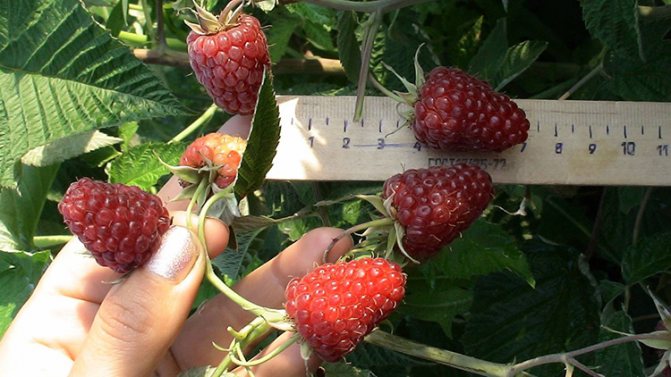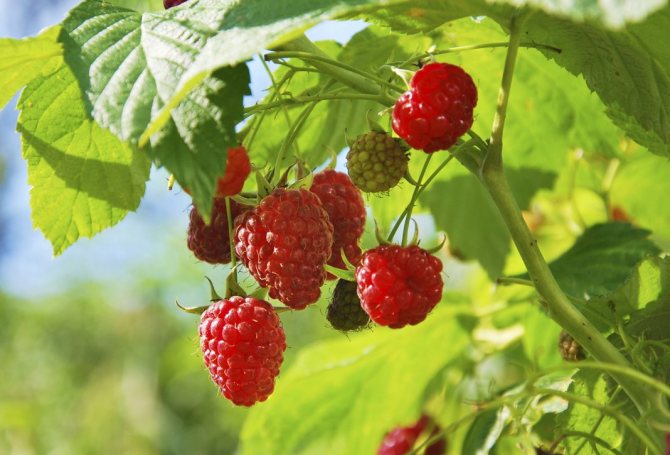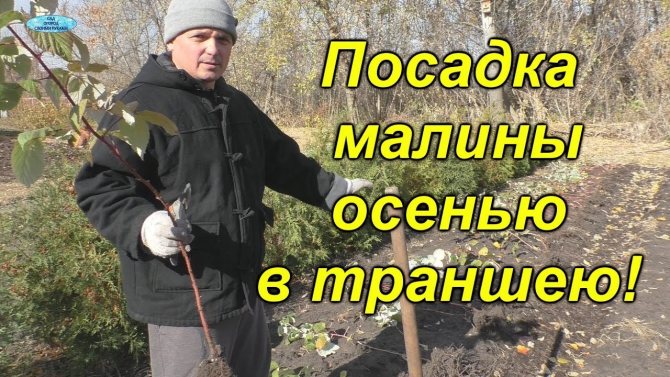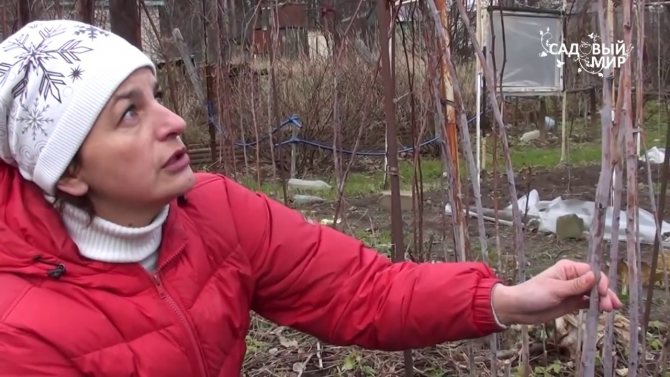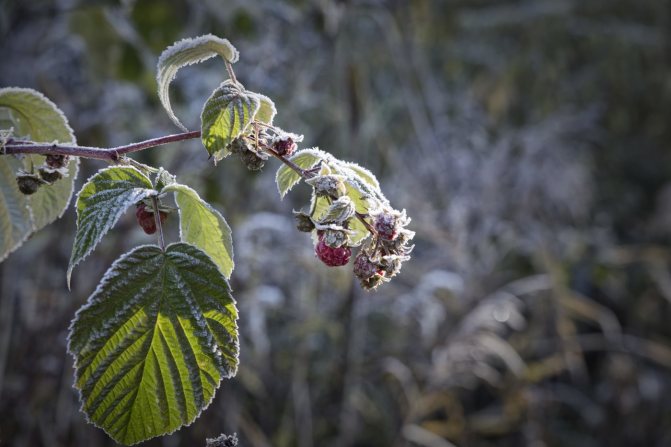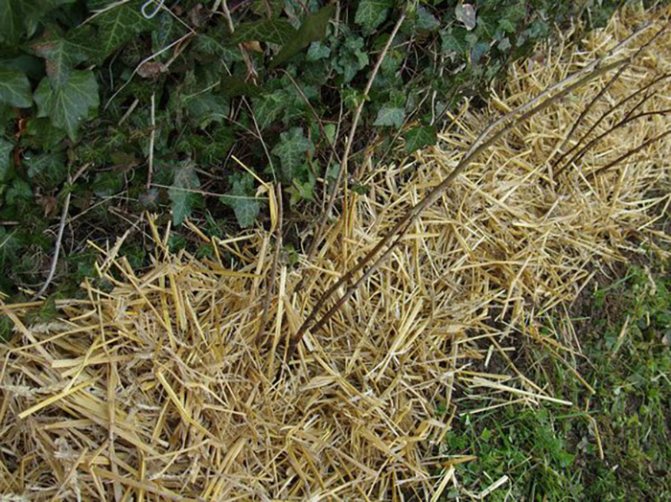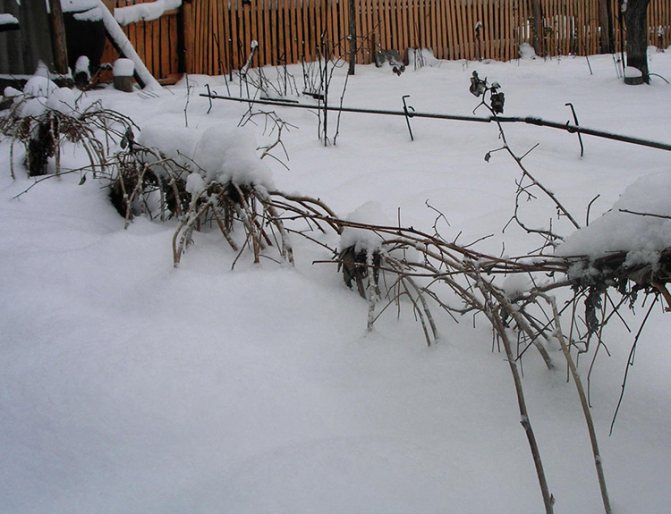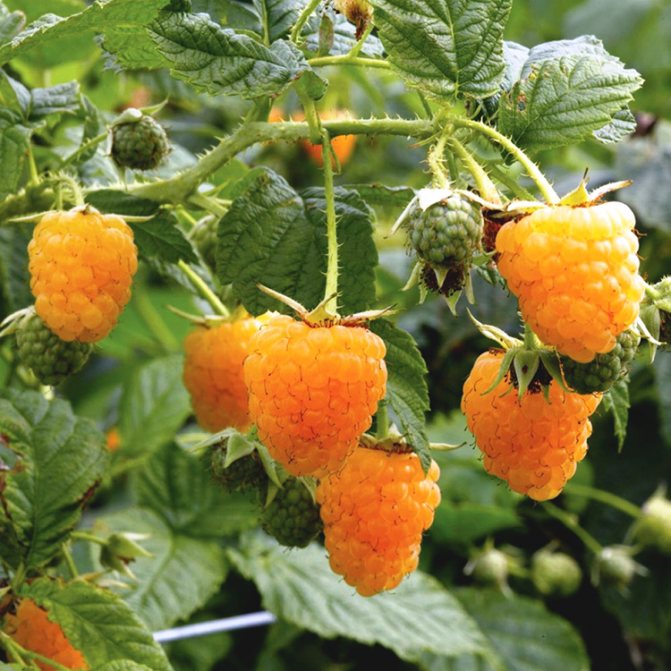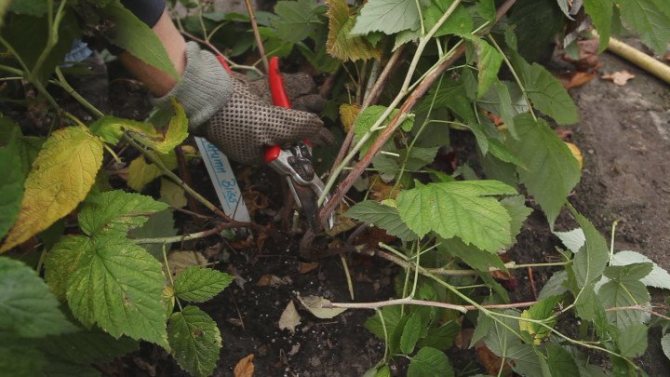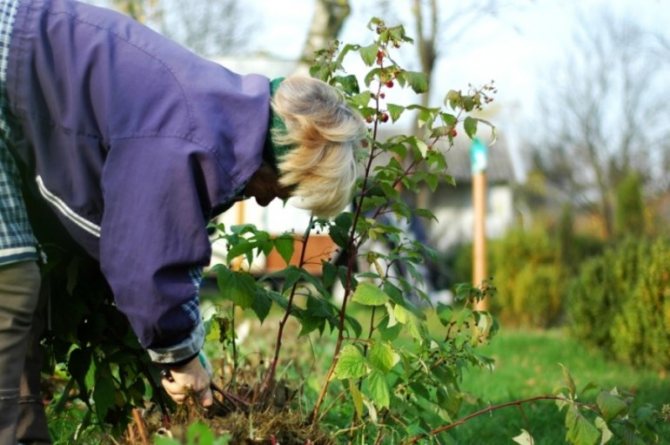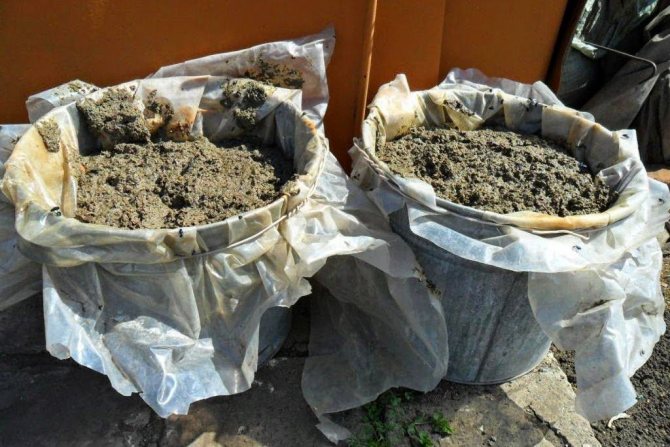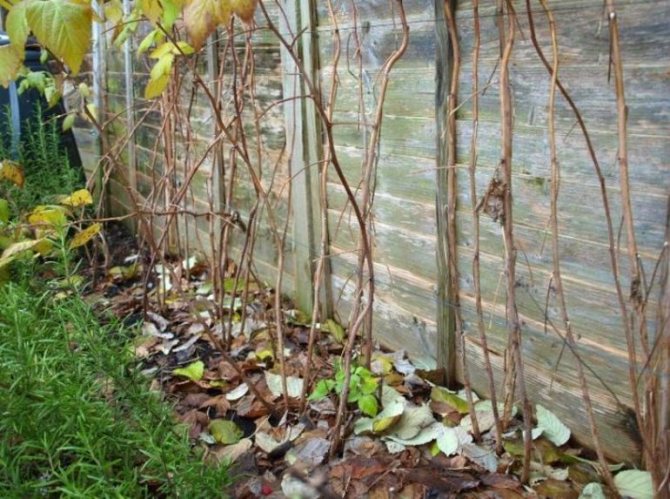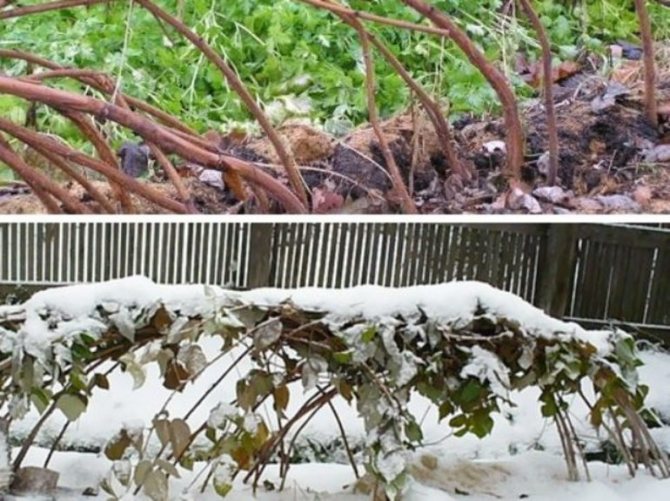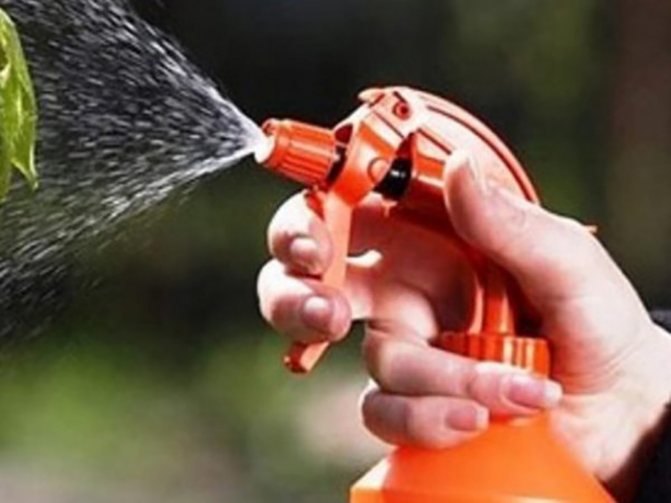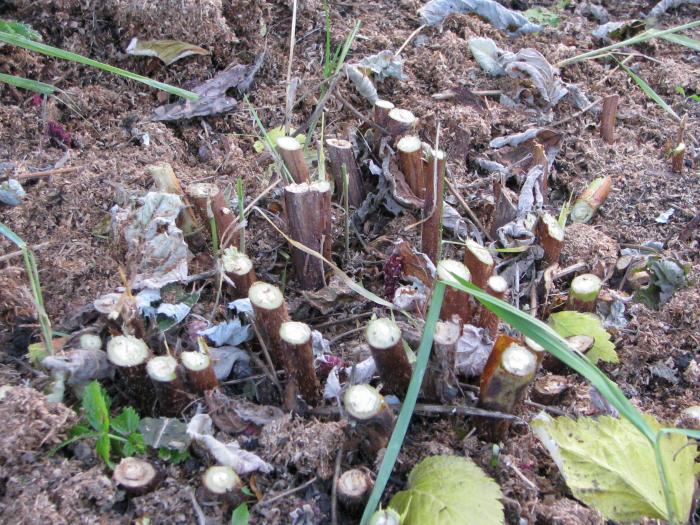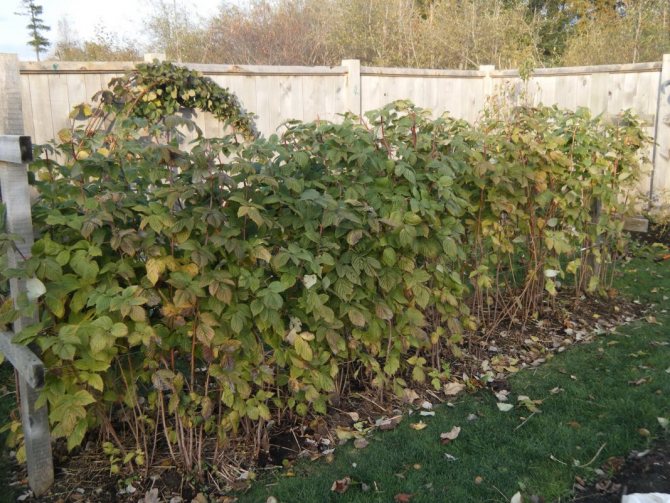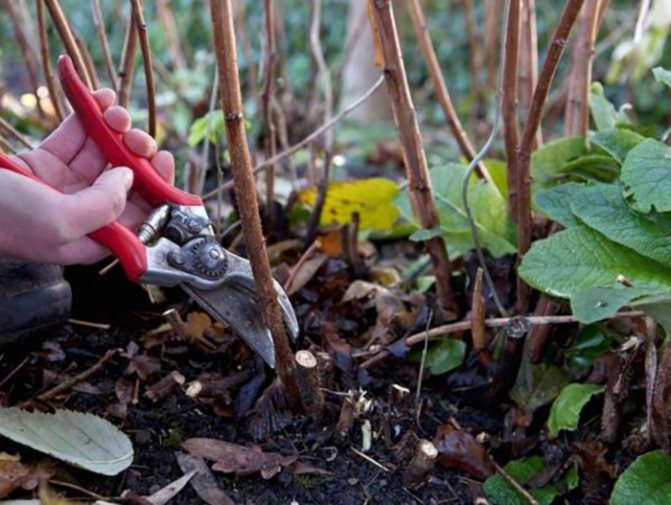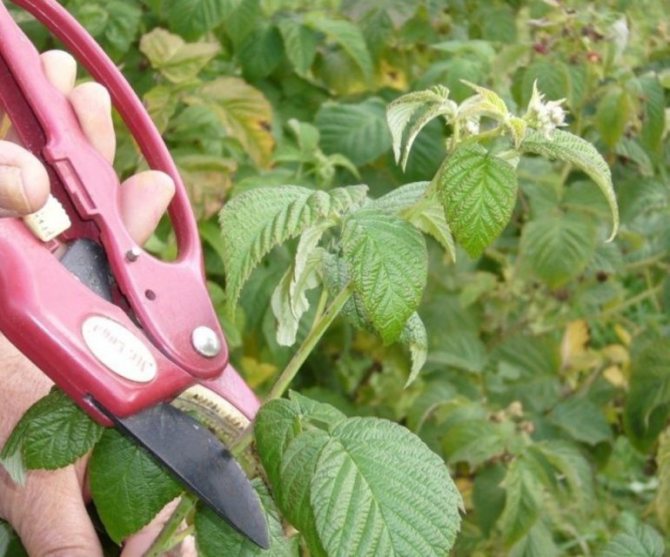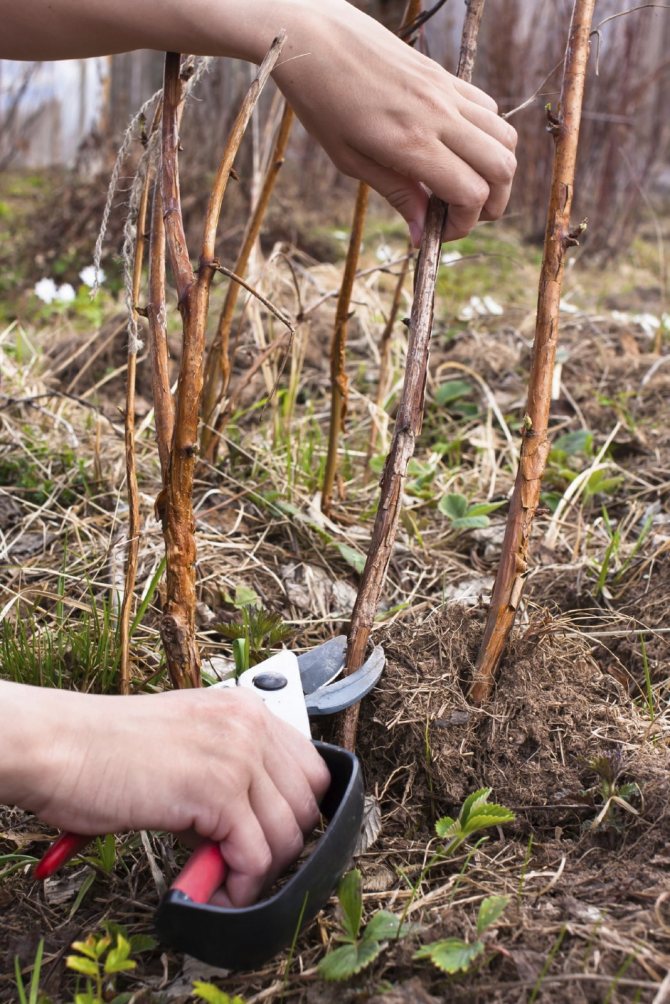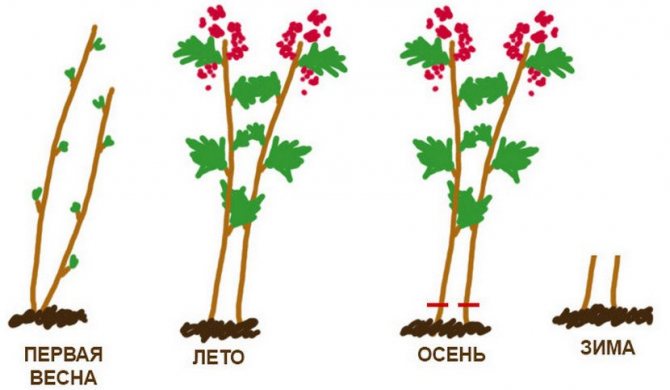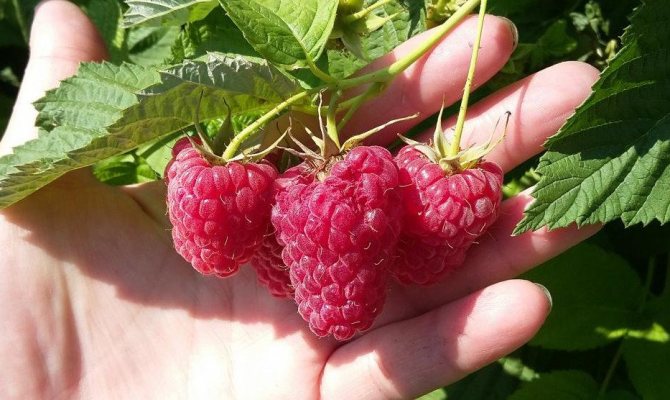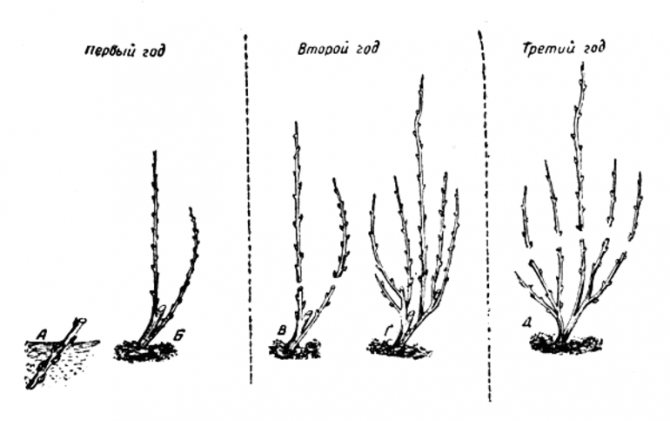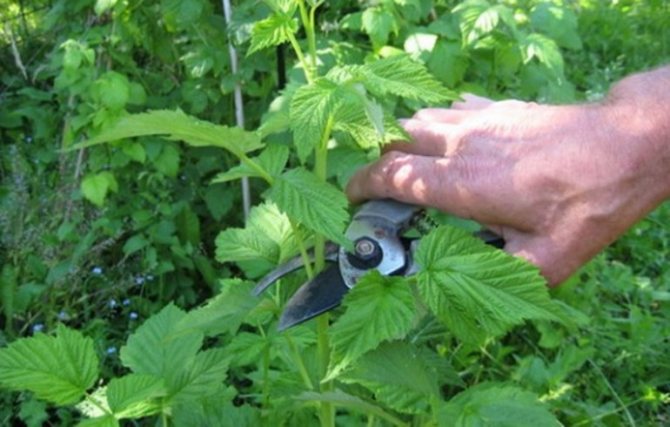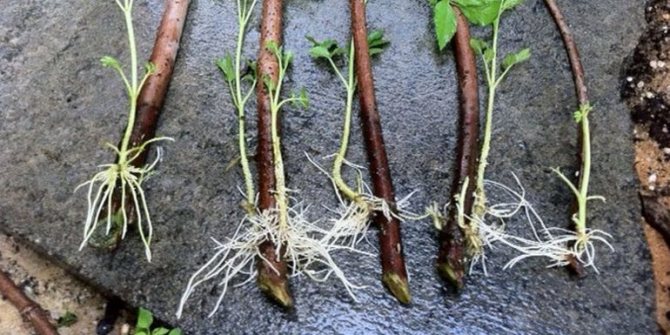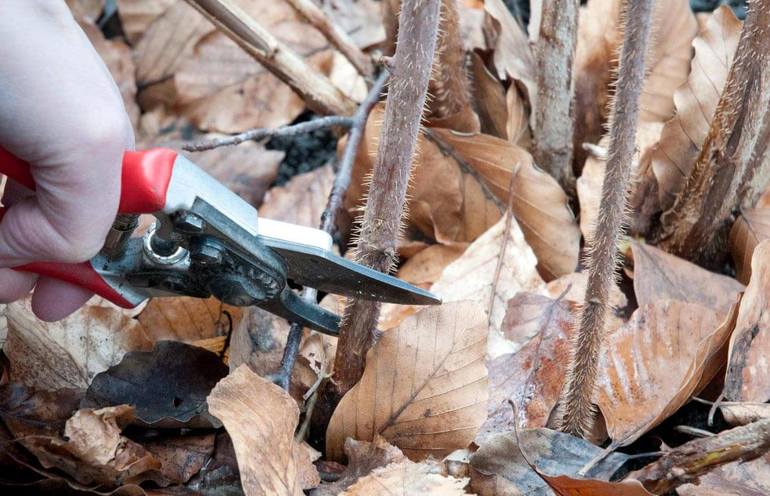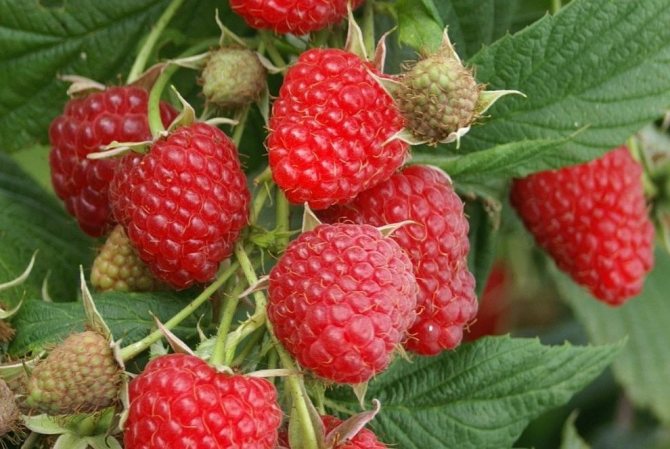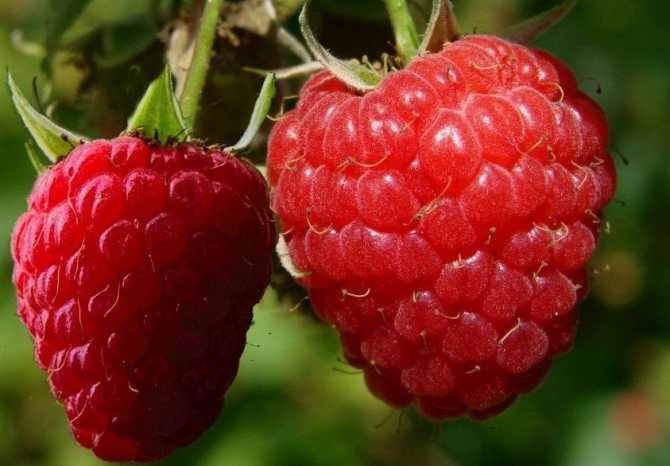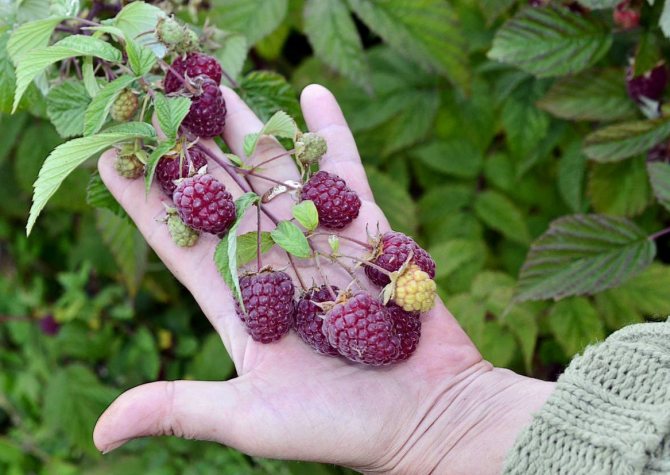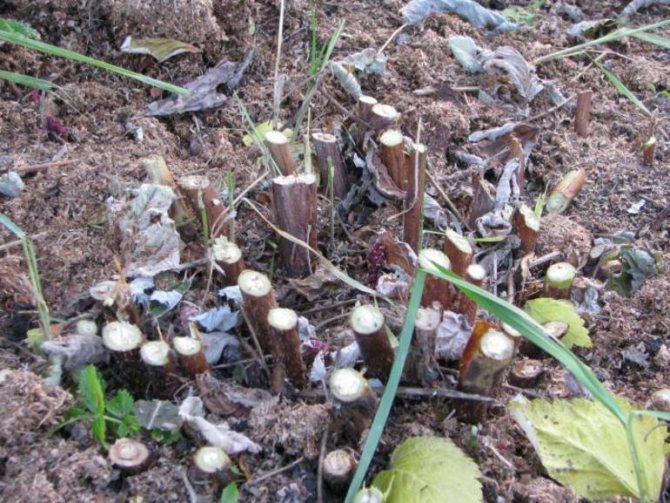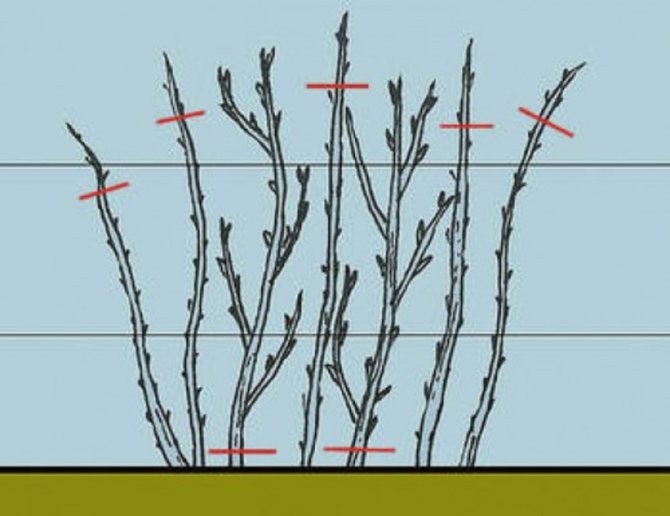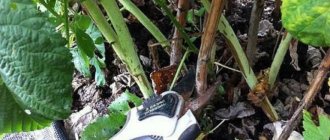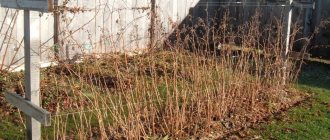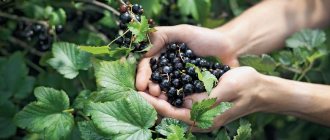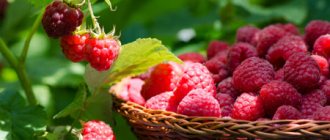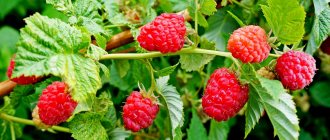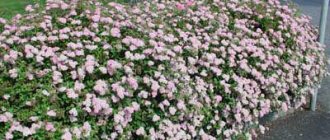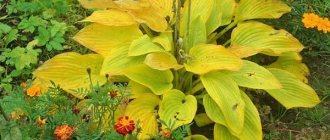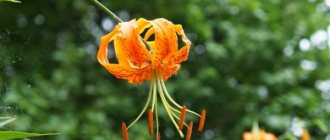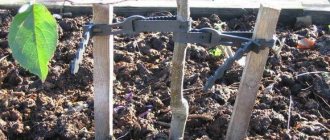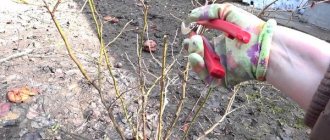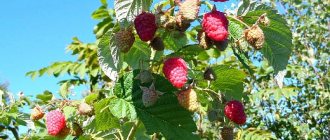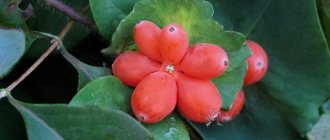Cool autumn days came, fruits and berries were harvested in the garden, and it was time to do other procedures to prepare plants for winter. For example, raspberries require attention in autumn, the care, pruning and feeding of which will help the bushes to overwinter and lay a good future harvest.
Cooking raspberries for winter
Preparing for winter also involves mulching with peat, rotten foliage, and straw to regulate air and moisture circulation in the topsoil.
The layer of the applied mulch should be from 5 to 10 cm. If less - there may be soil freezing and death of plants, if more - cause a fungal disease, which will reduce the immunity of raspberries.
Mulching is especially necessary in regions with severe frosts. Before starting, you should water the bushes well so that the plant does not go into the winter with an overdried root system.
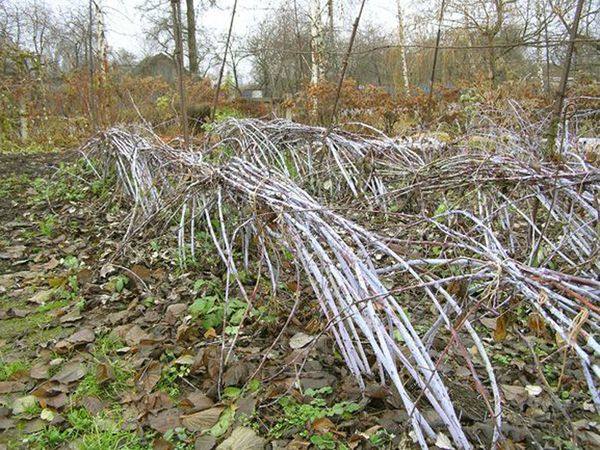
Raspberry bushes after pre-winter bending
The next stage of preparation involves bending down. The bushes are tied in bunches and bent to the ground. This is done so that in winter they are completely covered with snow. The beams are fixed to the ground using arcs, or tied to each other. The height is needed no more than 40 cm from the ground.
If the climate is harsh, you can cover the plants with non-woven fabric.
In winter, the material must not be covered with an ice crust. It is broken to allow air to pass through. The ideal time for these works is the period after the leaves fall, before the snow falls.
Like all garden plants, raspberries need regular maintenance. Autumn is a crucial period. The raspberry must be prepared for winter. Trim branches, fertilize the soil, mulch, bend and cover the plants. The future harvest will depend on the effectiveness of the autumn work.
If you adhere to simple rules that are understandable even to a novice gardener, spend a little time and effort, then the raspberries will safely overwinter and in the spring will grow with renewed vigor.
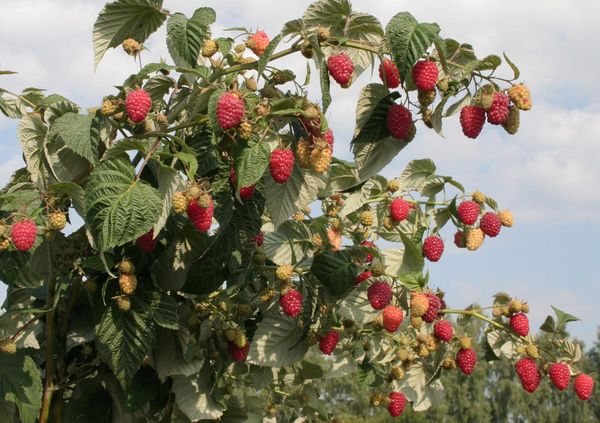

In order for the remontant raspberry to please with the harvest every year, it needs good care and timely pruning. During the fruiting period, the plant loses nutrients. Top dressing in the fall should be included in the list of mandatory activities.
Forming and sanitary pruning
Preparation of raspberry bushes for wintering begins with cleaning the area and pruning branches. This should be done after the late harvest, after the leaves begin to fall off on their own.
Algorithm of work:
- Cut off all leaves, young unripe shoots. At negative temperatures, they will die and become a source of rot for healthy branches.
- All damaged parts of the plant are necessarily cut off and removed from the site. They must be burned immediately to prevent contamination of other crops.
- Old branches are pruned to a height of 20-25 centimeters from ground level. Then they will need to be bent to the ground and secured.
- Thin out all the young growth that has grown between the bushes. For comfortable growth, there should be at least 50-60 centimeters of free space between the plants.
- Dry earth or peat must be sprinkled on the root area. You can cover the branches with a thick cloth or agrofiber. Do not use polyethylene and other airtight materials to prevent rotting of the shoots.Straw or spruce forest is often used as a shelter; in winter, you can additionally rake snowdrifts onto the shoots.
It should be noted that the fall pruning procedure is extremely important for the care of raspberries. This will prevent thickening of the shoots, increase productivity, and also allow you to take care of the plantings without any problems.
You may be interested in: Currants in the fall: care, pruning, feeding and other autumn work
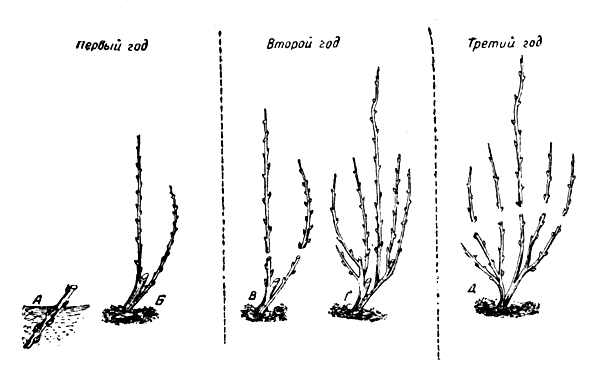

Raspberry care rules in autumn
Autumn care involves stages. Start to them after harvest... It:
- fertilization
- pest control
- pruning and pruning shoots and branches
- soil mulching
- garter and winter bending
Fertilizers are needed so that the plant replenishes the necessary nutrients before winter. With the help of pruning and pruning, they get rid of insect pests of the plant and the fungus that have settled on the tops and leaves of the plant. The main thing then remove cut branches and foliage and burn... You can also spray insects.
Old unnecessary shoots are removed by pruning, limiting the height of a mature plant. It is important to monitor the growth of the bushes. The distance between them is 60 -70 cm and one and a half meters between the rows. Plants should receive a lot of lightto give a good harvest.
When mulching, the soil is covered with straw, peat, sawdust, foliage. You can use commercially available material. It helps keep moisture in the soil and regulates air and water regimes.


Mulching raspberries helps to retain moisture in the soil
The garter and bending help the plant to survive the cold winter safely. The bushes are tied in bunches and bent down so that the snow falls over them, and they do not freeze.
Autumn watering raspberries
Processing raspberries in the fall does not end with pruning. Many novice gardeners forget about the shrub after harvest, although at this time it needs more watering. In August and September it can still be very hot, and this weather contributes to overdrying the shoots, which will affect the number of buds.
There is no need to water the bushes if it is rainy or the first night frosts have already begun. This can damage the root system, especially in young seedlings.
If it is very hot, then watering is carried out every week, spending up to 40 liters of liquid for each adult plant. Young bushes require less moisture - about 20 liters. It is good if there are hollows in the aisles where water will stagnate so that it does not spread. Or each bush has a groove around the central shoot at a distance of up to 40 cm.
The root system of raspberries is located horizontally in the ground, so it is not the shoot itself that needs to be moistened, but the soil around it within a radius of up to 50 cm.The roots go no more than 35 cm deep. ... If surface watering is carried out, the roots will be exposed and the plant will freeze in winter.
Raspberries reproduce poorly by seed, but grow well with the help of root suckers. If there are enough nutrients and water in the soil, the plantation will grow rapidly.
Autumn shrub pruning
An important autumn event is raspberry pruning. it will increase productivity next season.
First, you should cut out unnecessary shoots, form neat bushes. Then in winter the plant will not waste energy on maintaining vital activity in the extra stems.
Secondly, pruning helps fight harmful insects. Raspberry pests and fungi tend to accumulate on top of raspberry stems and leaves, and pruning will help control them.
Fallen leaves and cut branches should be remove from the site... This will help get rid of the pathogenic microorganisms developing in them, which, after overwintering, can destroy the entire raspberry tree in the spring.
On the bush, it is recommended to leave any nine shoots... This is the amount for which the plant has enough nutrients. Pruning is recommended before frost, in October.
- fruiting shoots
- branches with pests, fungus, old
- young sprouts, will not survive the winter
- broken branches
- useless shoots that thicken the bush
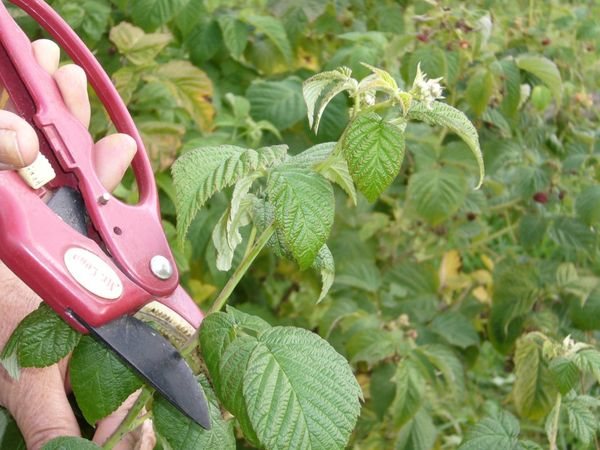

Pruning raspberry shoots that thicken the bush
Gardeners use several types of pruning. The main, often used, are three:
- trimming normal
- double cropping
- trimming for shortening
Regular pruning - remove 70 percent shoots. Complete removal of the stem is possible. Depends on the variety. If the variety has good vegetation, then the bush is cut off entirely. By next summer it will be one meter high. If growth is slow, then pruning is done by 50 - 70 percent.
It is also called Sobolev pruning. The first pruning is done when one-year-old branches reach 70 - 100 cm in height. In time, this is the end of May - beginning of June.
Cut off the top 10 - 15 cm... This leads to the growth of lateral branches. By the fall, they grow 50 cm. Berries will grow on them next season. The main thing is not to be late in time, so that new shoots do not die before winter. A second pruning is done the following spring when the leaves grow. At the side shoots, the tops are cut off by 15 cm.
If everything is done correctly, then:
- the term of fruiting raspberries will increase
- more flower buds are formed on the bush
- yields will increase in summer
To shorten
Pruning for shortening is easy. Bush cut at the root... This method is for varieties that do not give a large yield, which have a low degree of vegetation. This speeds up the growth of two-year shoots, which increases the yield. In addition, using this method, you can control pests by removing them from the garden along with cut shoots.
When doing pruning, you need to remember some rules.
- The cut branches are immediately removed and burned to avoid pest breeding.
- New branches are left as much as old ones are cut.
- The wider the shoots grow, the better.
Autumn pest control
The key to a rich harvest next season is the treatment of raspberries from pests and diseases. After harvesting, it is recommended to thoroughly weed the area, loosen the soil to a depth of 10-15 cm. These measures will help get rid of the pests preserved in the foliage and will not allow the larvae to overwinter in the soil.
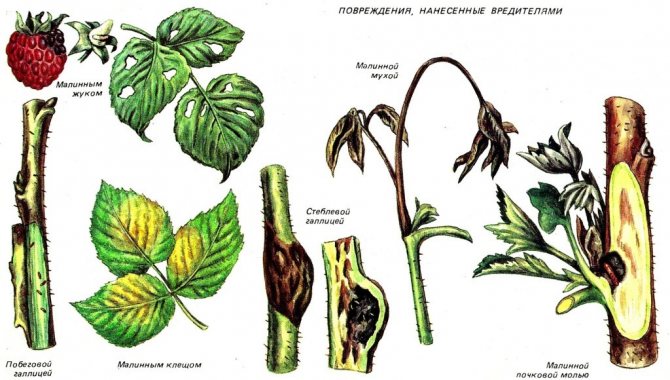

The most common harmful insects include: raspberry beetle, flower beetle, spider mite, stem fly.
It is able to significantly reduce the yield of berries or even lead to the death of the plant. Insects eat buds and fruits. The berries are poorly formed, grow deformed, wither and rot.
Beetles / larvae overwinter in the upper layers of the soil (at a depth of 15-20 cm.
Most often it lives on the seamy side of the leaves. Feeding on plant sap and multiplying, the tick gradually affects all parts of the bush: buds, leaves, shoots. When plants are damaged, flowering stops, the formed buds disappear.
A favorable breeding environment for the pest is thickened plantings, dry weather.
With the active spread of the tick, you can lose up to 70% of the crop. The tick hibernates on fallen leaves, weeds, therefore, the destruction of dry foliage, weeding of beds are the best preventive measures to combat the pest.
It actively develops in the branches of plants, causing the wilting of the shoots. To prevent the spread of the pest, it is recommended to cut off the damaged tops of the stems.
You should not be too zealous - only the upper part of the infected stems is cut. The cut pieces are immediately burned, as the larvae remain in them.
The optimal insect control is the autumn application of insecticides. Several tools have proven themselves well:
- Funafon - 10 ml of the product is diluted in a ten-liter bucket of water. A liter of solution is enough to process one bush;
- Intavir is available in tablets. Dissolve one tablet in a bucket of water;
- Actellik - sold in 2 ml ampoules. To prepare the solution, dilute one ampoule in two liters of water.
A solution of copper / iron sulfate can protect the bushes from lichen, moss or fungi. To increase the effect, it is recommended, in addition to plants, to process the soil near raspberries.
Fertilizing raspberries in the fall for a good harvest
Autumn feeding very important for future yields... By the end of the summer season, raspberries are drawing nutrients from the ground. In order for it to overwinter and prepare for the new season, it needs to be fed.
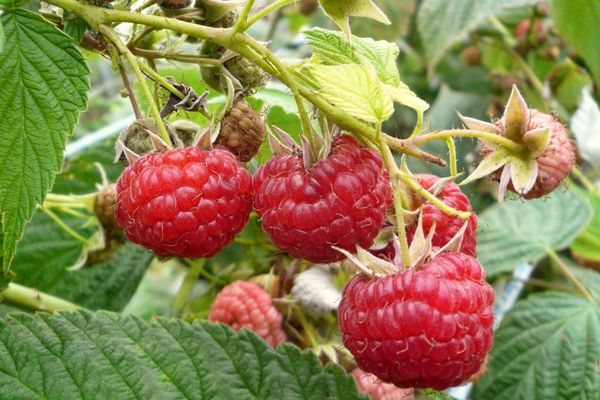

Autumn feeding of raspberries is very important for future yields.
If the composition of the soil is not replenished, then next year the growth of raspberries and fruiting will worsen. Therefore, it is imperative to feed in the fall. There are several ways to handle it. Via:
- chicken droppings or manure
- potash fertilizers
- nitrogen and urea
- peat and green manure
- If raspberries are missing phosphorus, it will have small leaves and thin stems.
- The appearance of yellow leaves with green veins will indicate a lack of gland.
- Leaves grow slowly and turn yellow, starting from the center to the edges, this indicates a lack of magnesium.
- If the raspberry has small yellow leaves that no longer grow, the plant does not have enough nitrogen.
- The leaves darken and processes begin to form quickly - an excess of nitrogen.
- The edges of the leaves are brown, as if "burnt" - the plant lacks potassium.
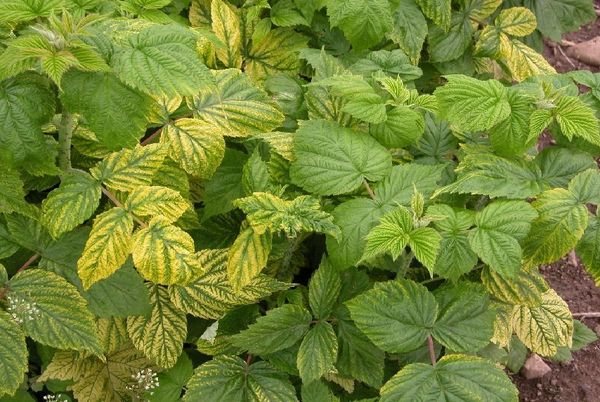

Yellow raspberry leaves with green veins indicate a lack of iron.
Chicken droppings
Chicken manure is an effective fertilizer. It contains nitrogen, potassium, calcium, phosphoric acid, magnesium, zinc, sulfur and boron. After two weeks of use, you can see a positive result.
Litter is a highly concentrated fertilizer. It is not used in its pure form. Only as a solution or compost.
Fertilizer must first lie down and pepso that poisonous ammonia leaves it. Then the droppings are diluted in water in a ratio of 1:30 and the bushes are watered with a solution. Fertilize the shrub with droppings in the fall. By the beginning of cold weather, the fertilizer will grind and begin to supply the plants with the necessary substances. Raspberries will overwinter and will actively grow in the spring.
Also, this fertilizer can be added to the compost. Chicken droppings, weeds, foliage, peat are placed in the compost heap. The finished compost is applied at the root in the fall. For 1 sq. m you need to make 10 Kg... The most important thing in using droppings is to keep the proportions correctly so as not to destroy the entire raspberry tree.
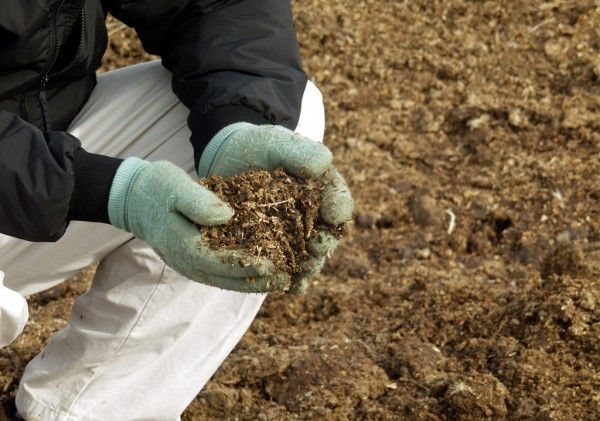

When feeding raspberries with chicken droppings, it is very important to observe the proportions
How to feed with mineral fertilizers
It has proven itself well among gardeners monophosphate... It contains 52% phosphorus and 34% potassium. This fertilizer dissolves well in water and is completely absorbed by plants. It must be added to the soil layer under the roots at the rate of 40 grams per bush.
Another good potassium-based fertilizer is potassium magnesia... It contains magnesium. It is also introduced at the root. The dose is 80 grams per plant.
An excellent recipe for mineral feeding of raspberries. In a bucket of water they dilute:
- 60 grams of superphosphate
- 40 grams of potassium salt
- 30 grams of saltpeter
Mix thoroughly and add to the raspberry patch. Instead of salt, you can take wood ash.
About fertilizing raspberries nitrogen in the fall, among gardeners there was an opinion that to do this not worth it... The best time for nitrogen fertilizers is spring. Nitrogen provokes strong growth and development of new branches. This will lead to their freezing, they will not have time to prepare for winter.
Peat necessary to improve the quality of the soil. It loosens the soil, and the roots of the plants receive more oxygen. It is recommended to use peat as mulch and as part of ready-made composts.
At the end of summer recommended in raspberry aisles sow plants - green manure... It:
After planting and fully ripening, they will feed the raspberries. After harvesting them mowed and then dug up with the ground... By spring, the mass will rot and serve as a source of trace elements for horticultural crops.
In order for the applied fertilizers to bring only benefit, the roots of the plants must be covered. You can cover with peat, sawdust and cut grass.
Favorable and unfavorable days according to the lunar calendar
In the fall of 2020, the greatest benefits will come from caring for plants on the following days:
- September - 23rd and 24th, from 26th to 30th;
- October - from 1 to 3, 8, from 10 to 16, from 20 to 23, from 25 to 30.
It is not recommended to work with plants: September 25 (full moon), October 9 (new moon), October 24 (full moon).
Caring for raspberries in the fall, preparing for winter does not imply special, difficult events. If you consistently follow all the recommendations of experienced gardeners, then even novice summer residents and gardeners can grow and harvest decent harvests of delicious berries.
At the end of the season, the gardener still has a lot of work to prepare the garden for wintering and ensure the future harvest. On plantings of raspberries, it is necessary to trim, loosen and feed the bushes, as well as, if necessary, provide a winter shelter. Our article will tell you how the autumn feeding of raspberries, pruning and other important measures for the care of the crop is carried out.
Cooking raspberries for winter
Preparing for winter also involves mulching with peat, rotten foliage, and straw to regulate air and moisture circulation in the topsoil.
The layer of the applied mulch should be from 5 to 10 cm... If less - there may be soil freezing and death of plants, if more - cause a fungal disease, which will reduce the immunity of raspberries.
Especially mulching is necessary in regions with severe frosts... Before starting, the bushes should be well watered so that the plant does not go into winter with a dry root system.
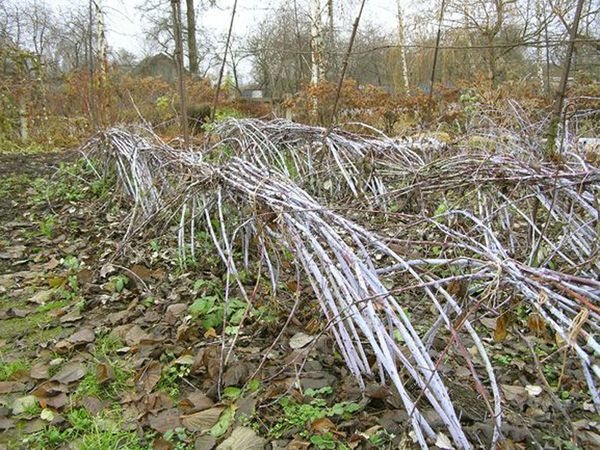

Raspberry bushes after pre-winter bending
The next stage of preparation involves bending down... The bushes are tied in bunches and bent to the ground. This is done so that in winter they are completely covered with snow. The beams are fixed to the ground using arcs, or tied to each other. The height is needed no more than 40 cm from the ground.
In winter, the material must not be covered with an ice crust. It is broken to allow air to pass through. The ideal time for these works is the period after falling leavesbefore the snow falls.
Like all garden plants, raspberries need regular maintenance. Autumn is a crucial period. The raspberry must be prepared for winter. Trim branches, fertilize the soil, mulch, bend and cover the plants. The future harvest will depend on the effectiveness of the autumn work.
If you adhere to simple rules that are understandable even to a novice gardener, spend a little time and effort, then the raspberries will safely overwinter and in the spring will grow with renewed vigor.
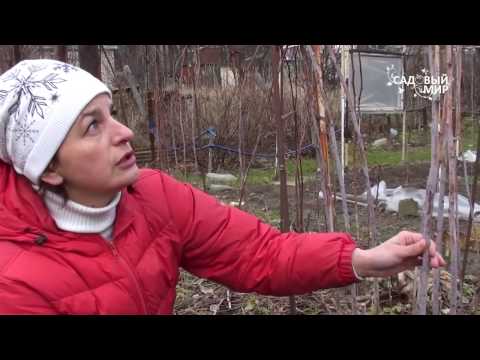

Raspberry is a widespread berry culture in central Russia. The fruiting season is from June to early July. To achieve a rich harvest, you need to take into account a number of nuances, the main of which is pruning raspberries in the fall.
Preparing bushes for winter frosts
How well you prepare the bushes will affect the volume of raspberries and the plant's resistance to certain diseases.
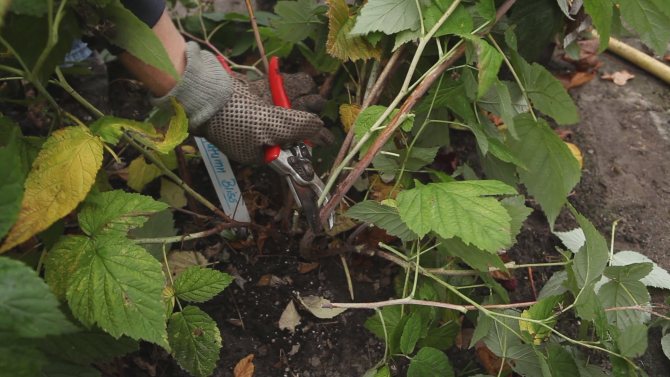

What relates to preparation activities:
- pruning weak and old stems;
- removing all leaves;
- correct mulching;
- shelter, which is made for the winter period;
- application of various fertilizers.
Important!
The main points of preparing remontant raspberries for winter are the application of fertilizer with a significant amount of phosphorus, as well as potassium, high-quality pruning and insulation.
Let's talk about each stage in more detail.
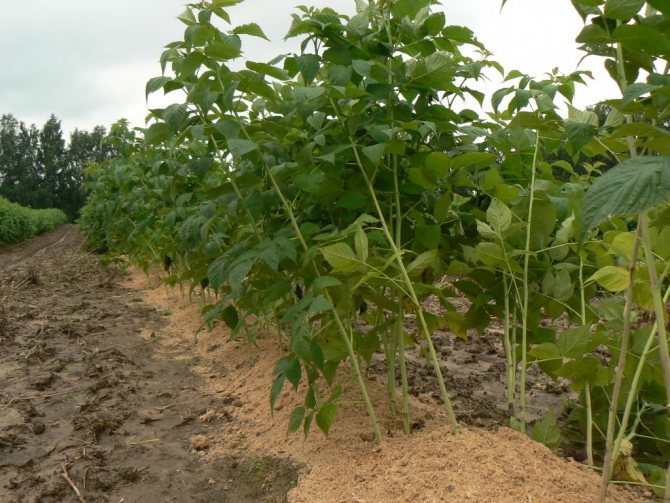

Why prune raspberries in the fall?
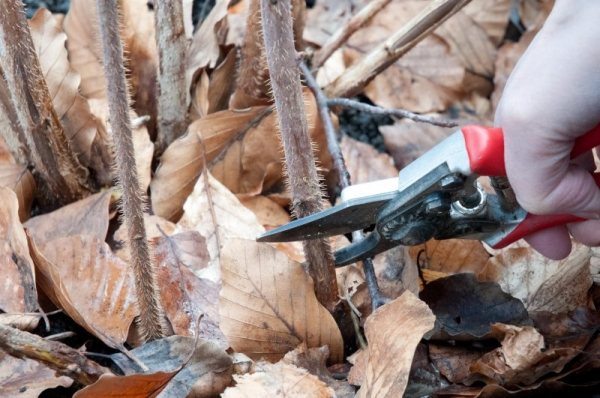

Autumn pruning is done for three reasons:
- in raspberries, only shoots no more than two years old bear fruit. Therefore, old branches can be removed at the root. If this is not done, the raspberry tree turns into dense thickets and gives rare small berries.
- remontant raspberries lose a lot of energy during fruiting, which is not limited to one or two months. In order for the bushes to have a sufficient supply of nutrients for the harvest by the next year, it is necessary to rid the root system of excess ground parts before the onset of winter cold weather. Thanks to this, the roots do not waste juices, accumulating useful elements.
- pruning will call to get rid of disease-causing spores of fungi and pests that live on the wood. If done correctly, a powerful wave of growth can be expected in the spring.
Trimming technique
Raspberry pruning is carried out from September to early November, or shortly before frost if winter promises to be early. Sometimes there are recommendations to start this immediately after the last harvest. For remontant raspberries, this is true, that is, already at the beginning of September, you can start working. But it is allowed to do it later. The main thing is to be in time before the cold weather.
The technique is simple and consists of the following stages:
- With the help of a sharp pruner, weak, diseased, thin, old shoots and those that clearly thicken the planting are first removed at the root.
- There should be some space between the branches: tight interlacing of the trunks is unacceptable. The optimal number of shoots that can be left on one bush is 8-10 pcs.
- All fallen raspberry leaves and broken off twigs are removed with a rake. Unripe (not yet lignified) branches are shortened. Leave strong annual lignified tops. All plant debris is raked out and burned.
- After that, they start trimming the trunks that have successfully passed a rigorous selection.
How high should you cut?
The height to cut raspberries depends on the age of the shoots and the strength of their growth. Biennial stems are removed at the root. Annual tops are shortened by 30-80%. Moreover, the more powerful the growth force of a given variety, the more they are cut off. The approximate height of the trimmed shoot should be 1-1.4 meters. Some varieties (Indian Summer-2, Penguin, Hercules, Diamond) bloom and bear fruit extremely profusely in the first year. They should be cut completely: young shoots will grow from the roots in the spring.
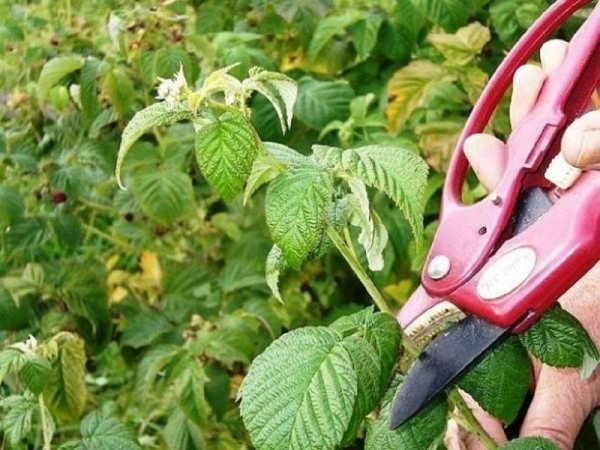

The remaining leaves are removed from each branch with pruners, which are immediately sent to the fire or at least to the compost pit at a decent distance from the raspberry tree.
In the southern regions, double pruning is practiced, which is carried out in two stages. In the first year, at the very beginning of June, when annual tops reach a height of 80-100 cm, the tops are cut by about 15 cm. As a result, branches of the second order begin to grow actively. In late spring of next year, when the leaves bloom, these side shoots are also shortened by 15 cm. In June, they will give a bountiful harvest and will delight the gardener with berries until October.
Important! Having finished pruning, you can treat the remaining ground parts with a solution of phytosporin or ferrous sulfate to destroy the pathogenic environment on the wood.
Essential tools for pruning raspberries
There are no trifles in this business. And one of the factors that should not be neglected is the sharpness of the pruner. It is more convenient to use special scissors for thorny bushes, which are distinguished by longer handles. Sometimes it happens that a thick shoot cannot be cut evenly with a pruner: it seems to be crumpled between the blades. For such cases, in order to align the cuts, you need to have a sharp razor or a garden knife-blade.
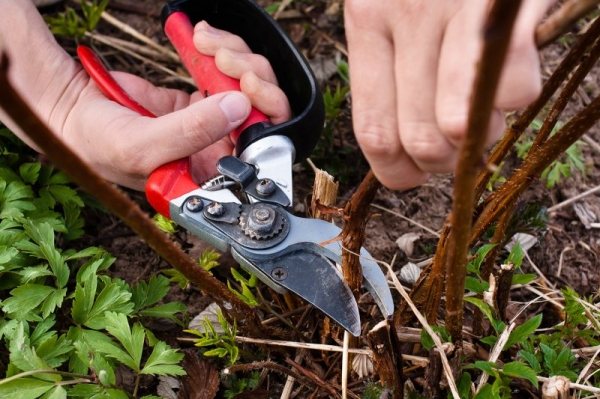

Another type of pruner is the lopper. To work with raspberry bushes, it is unlikely to be needed, unless we are talking about neglected plantings, where there are already three-year-old trunks.
You will also need a rake to rake not only thorny cut branches, but also any fallen leaves. In this environment, pests and pathogenic spores winter safely, so the collected organic matter needs to be burned.
Important! Blunt instruments leave burrs and irregularities on the cuts, which have a high risk of fungal infections.
Caring for raspberries after pruning
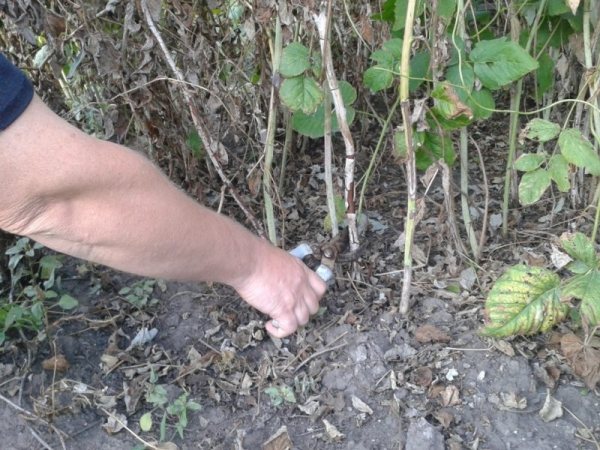

After pruning, the raspberry tree needs a little maintenance, which is as follows:
- The bushes should be watered thoroughly as the soil must nourish the stems in winter.
- To prevent freezing of the remaining raspberry vine, especially remontant, it is recommended to cover it for the winter.
- So that moisture does not evaporate, the soil around the shrub must be mulched. This event will also protect the root system from freezing, especially if the winter is not very snowy.
- Fertilizing raspberries is very important after pruning, since during the winter period it should not only rest, but also gain strength.
How and how to properly feed raspberries will be discussed in the next section.
Repaired raspberry - what is it and what is its peculiarity
The varieties that bear fruit on the shoots of the first and second years are considered to be repaired. Regarding raspberries, the term "remontant", which comes from the French language, means fruitful repeatedly. This raspberry has been known for about 200 years in Europe. At the beginning of the 19th century, 20 such varieties were cultivated, in the next century their number exceeded 60.
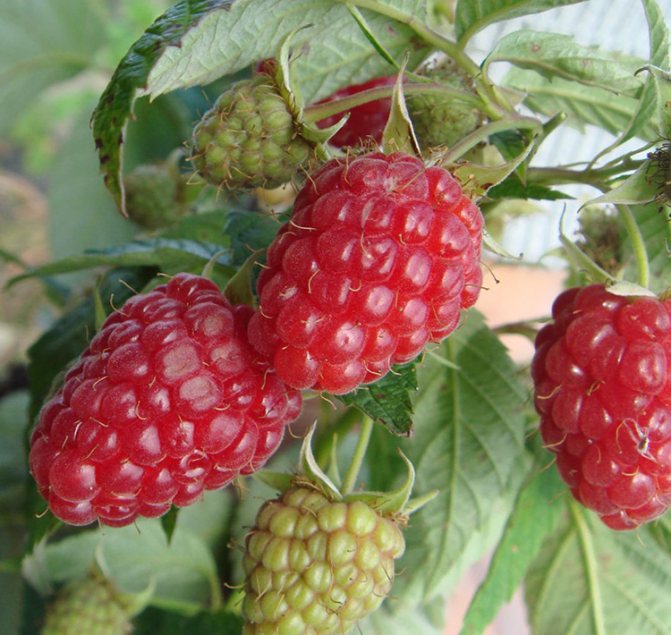

Variety "Autumn Beauty" has a rich taste


